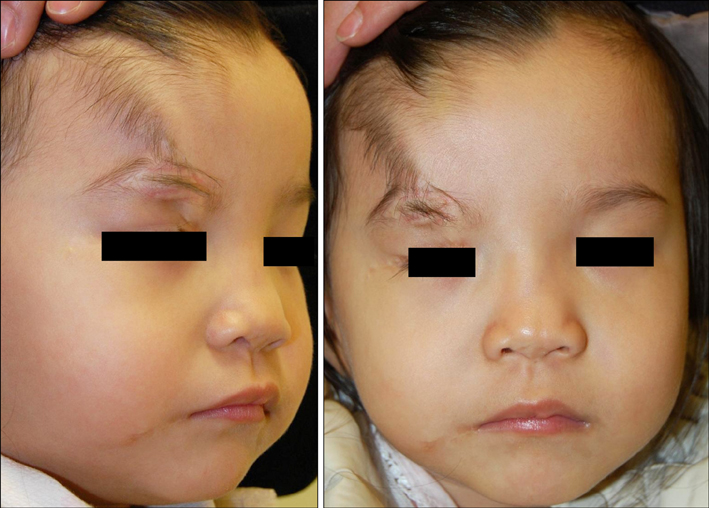Ann Dermatol.
2012 Nov;24(4):464-467. 10.5021/ad.2012.24.4.464.
A Wedge-Shaped Anterior Hairline Extension Associated with a Tessier Number 10 Cleft
- Affiliations
-
- 1Department of Dermatology, Asan Medical Center, University of Ulsan College of Medicine, Seoul, Korea. csesnumd@gmail.com
- 2Department of Pediatrics, Asan Medical Center, University of Ulsan College of Medicine, Seoul, Korea.
- 3SB Jinmi Dermatologic Clinic, Seoul, Korea.
- KMID: 2266044
- DOI: http://doi.org/10.5021/ad.2012.24.4.464
Abstract
- A wedge-shaped anterior hairline extension is a very rare skin manifestation usually associated with congenital anomalies including a Tessier number 10 cleft. Other associated conditions are the Tessier number 9 cleft, the Fraser syndrome, and the Manitoba oculotrichoanal syndrome (MOTA syndrome). The Tessier number 10 cleft features include a coloboma of the middle third of the upper eyelid, and an eyebrow divided into two portions. The medial eyebrow portion may be absent and the lateral portion is angulated vertically, joining the hairline of the scalp. This creates a wedge-shaped anterior hairline extension. Herein we report on a case of a wedge-shaped anterior hairline extension associated with the Tessier number 10 cleft.
MeSH Terms
Figure
Reference
-
1. Yeung A, Amor D, Savarirayan R. Familial upper eyelid coloboma with ipsilateral anterior hairline abnormality: two new reports of MOTA syndrome. Am J Med Genet A. 2009. 149A:767–769.
Article2. Kawamoto HK Jr. The kaleidoscopic world of rare craniofacial clefts: order out of chaos (Tessier classification). Clin Plast Surg. 1976. 3:529–572.3. Kawamoto HK Jr. McCarthey JG, editor. Rare craniofacial clefts. Plastic surgery. 4th ed. Philadelphia: WB Saunders;2922–2973.4. Fan X, Shao C, Fu Y, Zhou H, Lin M, Zhu H. Surgical management and outcome of tessier number 10 clefts. Ophthalmology. 2008. 115:2290–2294.
Article5. Tessier P. Anatomical classification facial, cranio-facial and latero-facial clefts. J Maxillofac Surg. 1976. 4:69–92.6. Langevin CJ, Gage E, Papay F. Siemionow MZ, Eisenmann-Klein M, editors. Craniofacial clefts and craniofacial syndromes. Plastic and reconstructive surgery. 2010. London: Springer-Verlag;253–264.
Article7. Marles SL, Greenberg CR, Persaud TV, Shuckett EP, Chudley AE. New familial syndrome of unilateral upper eyelid coloboma, aberrant anterior hairline pattern, and anal anomalies in Manitoba Indians. Am J Med Genet. 1992. 42:793–799.
Article8. Li C, Slavotinek A, Chudley AE. Pagon RA, Bird TD, Dolan CR, Stephens K, Adam MP, editors. Manitoba oculotrichoanal syndrome. GeneReviews. 1993. Seattle (WA): University of Washington.9. Eskander BS, Shehata BM. Fraser syndrome: a new case report with review of the literature. Fetal Pediatr Pathol. 2008. 27:99–104.
Article10. Li C, Marles SL, Greenberg CR, Chodirker BN, van de Kamp J, Slavotinek A, et al. Manitoba oculotrichoanal (MOTA) syndrome: report of eight new cases. Am J Med Genet A. 2007. 143A:853–857.
Article11. Slavotinek AM, Baranzini SE, Schanze D, Labelle-Dumais C, Short KM, Chao R, et al. Manitoba-oculo-tricho-anal (MOTA) syndrome is caused by mutations in FREM1. J Med Genet. 2011. 48:375–382.
Article12. Ibrahimi OA, Avram MM, Hanke CW, Kilmer SL, Anderson RR. Laser hair removal. Dermatol Ther. 2011. 24:94–107.
Article
- Full Text Links
- Actions
-
Cited
- CITED
-
- Close
- Share
- Similar articles
-
- Tessier number 7 cleft with unilateral complete cleft lip and palate: a case report
- Anatomical repair of a bilateral Tessier No. 3 cleft by midfacial advancement
- A Case of Rare Craniofacial Clefts: Tessier No .7 Cleft
- A modified presurgical alveolar molding technique for treatment of cleft in Down syndrome
- Two Cases of the Incomplete Upper Median Cleft Lip: New Classification



